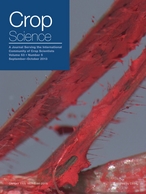Ver ítem
- xmlui.general.dspace_homeCentros Regionales y EEAsCentro Regional Buenos Aires SurEEA Cuenca del SaladoArtículos científicosxmlui.ArtifactBrowser.ItemViewer.trail
- Inicio
- Centros Regionales y EEAs
- Centro Regional Buenos Aires Sur
- EEA Cuenca del Salado
- Artículos científicos
- Ver ítem
Maize Physiological Responses to Heat Stress and Hormonal Plant Growth Regulators Related to Ethylene Metabolism
Resumen
Hormonal plant growth regulators (HPGRs) have been evaluated in field grown maize (Zea mays L.), but never as a tool for prevention or mitigation of heat stress. We analyzed grain yield determination of maize crops exposed to contrasting temperature regimes (nonheated control plots [TC]; heated plots [TH]) and the application of HPGRs associated with ethylene metabolism (ethephon [ETH]; MCP [1-MCP]). Heating extended over daytime hours between V11 and
[ver mas...]
Hormonal plant growth regulators (HPGRs) have been evaluated in field grown maize (Zea mays L.), but never as a tool for prevention or mitigation of heat stress. We analyzed grain yield determination of maize crops exposed to contrasting temperature regimes (nonheated control plots [TC]; heated plots [TH]) and the application of HPGRs associated with ethylene metabolism (ethephon [ETH]; MCP [1-MCP]). Heating extended over daytime hours between V11 and tasseling (VT), and products were sprayed immediately before (V11) and/or during (V16) heating. Plants treated with ETH always had reduced height (10–21%) and leaf area (3–10%), but these trends usually had no effect on light interception during treatment period. Biomass production was markedly affected by heating, but a significant interaction effect (P < 0.01) indicated that HPGRs caused (i) no effect among TH plots, and (ii) a decrease (13–19% for ETH and 3.8–9.4% for MCP) among TC plots. The interaction effect computed for grain yield highlighted that ETH had mild negative effects (≤ 18%) among TC plots and large positive effects among TH plots (up to 73%), whereas MCP had no effect among the former and mild positive (V16) or negative (V11) effects among the latter. Variations in grain yield were due to variations in kernel numbers (r2 ≥ 0.92), which were explained by ear growth rate around flowering (r2 ≥ 0.97). Timely application of HPGRs was critical for improving biomass allocation to the ear (ETH) and having adequate blockage of ethylene receptors (MCP).
[Cerrar]

Autor
Cicchino, Mariano Andres;
Rattalino Edreira, Juan Ignacio;
Otegui, Maria Elena;
Fuente
Crop science 53 (5) : 2135-2146. (July 2013)
Fecha
2013-07
ISSN
0011-183X
1435-0653
1435-0653
Formato
pdf
Tipo de documento
artículo
Palabras Claves
Derechos de acceso
Restringido
 Excepto donde se diga explicitamente, este item se publica bajo la siguiente descripción: Creative Commons Attribution-NonCommercial-ShareAlike 2.5 Unported (CC BY-NC-SA 2.5)
Excepto donde se diga explicitamente, este item se publica bajo la siguiente descripción: Creative Commons Attribution-NonCommercial-ShareAlike 2.5 Unported (CC BY-NC-SA 2.5)

